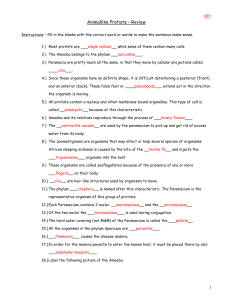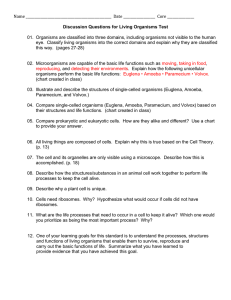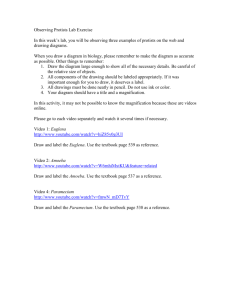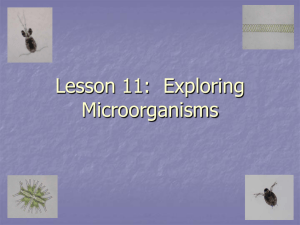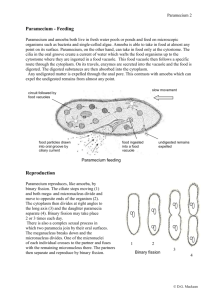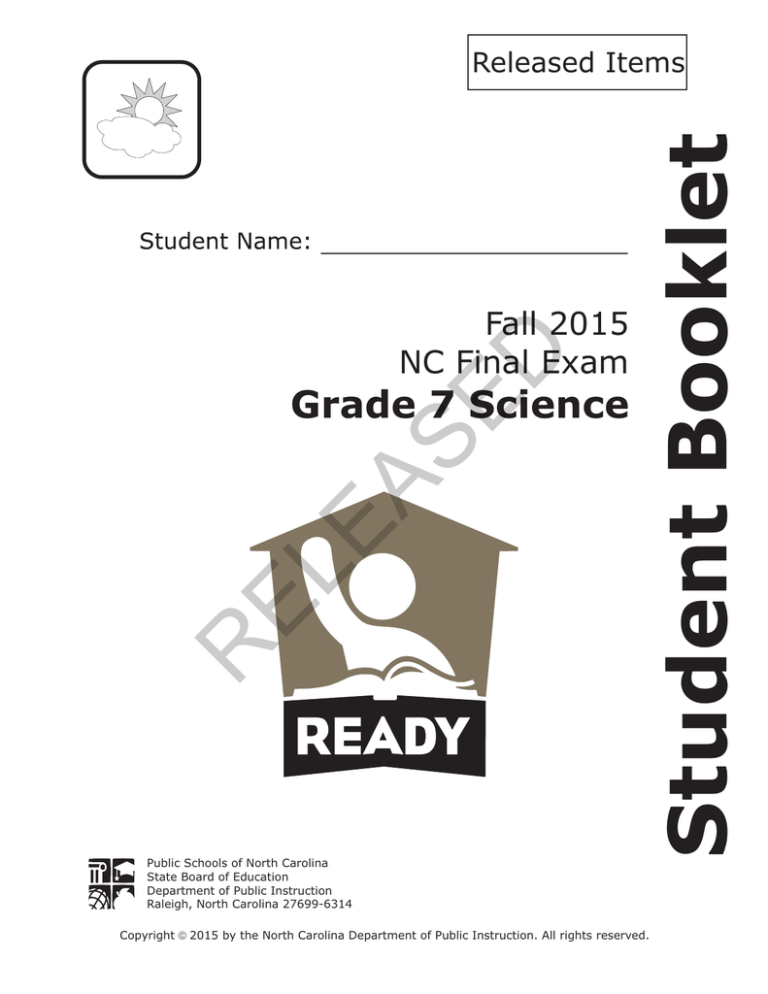
D
Fall 2015
NC Final Exam
R
EL
EA
SE
Grade 7 Science
Public Schools of North Carolina
State Board of Education
Department of Public Instruction
Raleigh, North Carolina 27699-6314
Copyright ã 2015 by the North Carolina Department of Public Instruction. All rights reserved.
Student Booklet
Released Items
GRADE 7 SCIENCE — RELEASED ITEMS
Sally ran a distance of 8 m in 16 s. The graph below shows her motion.
Distance vs. Time
8
7
6
5
D
4
3
2
1
2
4
6
8
10
EA
0
SE
Distance (m)
12
14 16
Time (s)
Which best describes her motion?
Her speed was constantly changing.
B
Her speed remained constant.
C
She stopped moving after four seconds.
D
She decreased her speed after four seconds.
EL
A
R
1
1
Go to the next page.
GRADE 7 SCIENCE — RELEASED ITEMS
B
The cart has no energy at the top and more energy at the bottom.
C
The cart has less potential energy at the top than it does at the bottom.
D
The cart has potential energy at the top that is transformed to kinetic energy
as it moves to the bottom.
How can simple machines make work easier?
D
The cart has greater kinetic energy at the top than it does at the bottom.
by decreasing the force needed to complete the task
B
by increasing the friction between the machine and the object
C
by adding more work on the object than originally applied
D
by removing the force of gravity on the object
SE
A
EA
4
A
Why does the troposphere experience the greatest amount of atmospheric
pressure compared to the other atmospheric layers?
EL
3
How does the energy of a roller-coaster cart change as the cart travels from the
top of the roller coaster to the bottom?
A
It produces the ozone layer.
B
It has the highest temperatures.
C
It contains a high concentration of gas particles.
D
It is the region in which weather occurs.
R
2
2
Go to the next page.
GRADE 7 SCIENCE — RELEASED ITEMS
The majority of evaporation takes place over the ocean.
B
The majority of precipitation takes place over the ocean.
C
Most rivers deposit freshwater into the ocean.
D
Most clouds form near or over the ocean.
sunny weather
B
stormy weather
C
calm weather
D
hot weather
SE
A
D
Barometric pressure has been dropping all day. What weather conditions will
most likely occur?
EA
7
A
A sea breeze blows from the ocean toward the shore. Why does this occur?
EL
6
Which explains why most of the rain that falls comes from the ocean?
A
High pressure over the land causes a downdraft to occur.
B
The tide carries the wind to the shore as it moves back and forth.
C
Conduction of heat from the warm water produces wind from the ocean.
D
Air over land heats faster than air over water, which causes convection.
R
5
3
Go to the next page.
GRADE 7 SCIENCE — RELEASED ITEMS
10
A
amoeba and paramecium
B
paramecium and volvox
C
volvox and euglena
D
euglena and amoeba
D
How do a paramecium and an amoeba obtain food to live?
A paramecium and an amoeba both use contractile vacuoles to capture food.
B
A paramecium and an amoeba both make their own food through
photosynthesis.
C
A paramecium collects food into an oral groove, while an amoeba uses
pseudopods to surround food.
D
A paramecium uses pseudopods to capture food, while an amoeba uses
chloroplasts to make its food.
EA
SE
A
EL
9
Which two organisms contain chloroplasts and eyespots?
Tina observed a cell under a microscope. She concluded that it was a plant cell
instead of an animal cell. Which structure helped her come to this conclusion?
A
She saw a vacuole, which animal cells lack.
B
She saw a nucleus, which animal cells lack.
C
She saw a chloroplast, which animal cells lack.
D
She saw a cell membrane, which animal cells lack.
R
8
4
Go to the next page.
GRADE 7 SCIENCE — RELEASED ITEMS
A
to provide the body with carbon dioxide, which reacts with food to produce
energy
B
to provide the body with oxygen, which reacts with food to produce energy
C
to provide the cells with glucose, which is used as a source of energy
D
to provide the cells with water, which is used as a source of energy
D
Why would the offspring resulting from fertilization have more differences than the
offspring resulting from budding?
Two parents provide all of their genes to their offspring during budding,
unlike during fertilization.
B
Each parent provides half of its genes to its offspring during budding,
unlike during fertilization.
C
Two parents provide all of their genes to their offspring during fertilization,
unlike during budding.
D
Each parent provides half of its genes to its offspring during fertilization,
unlike during budding.
EA
SE
A
EL
12
Which is a function of the respiratory system?
R
11
5
Go to the next page.
GRADE 7 SCIENCE — RELEASED ITEMS
13
Freckles (F) are dominant to not having freckles (f). The diagram shows the cross
of a homozygous dominant parent (FF) with a parent of an unknown genotype for
freckles.
F
F
?
Ff
Ff
?
Ff
Ff
15
B
homozygous recessive without freckles
C
heterozygous with freckles
D
heterozygous without freckles
EA
SE
homozygous dominant with freckles
Two black guinea pigs were crossed and they produced a litter of 4 black and
3 white guinea pigs. Which best explains this occurrence?
White fur is dominant to black fur.
B
White fur was the result of a mutation.
C
Both parents were heterozygous for black fur.
D
Both parents were homozygous for black fur.
EL
A
R
14
A
D
What is the unknown genotype and phenotype for the parent?
Doppler radar shows a vertical rotating column of air with high wind speeds.
Which is most likely occurring?
A
the formation of a hurricane
B
the formation of a tornado
C
approaching warm front
D
approaching snowstorm
6
Go to the next page.
GRADE 7 SCIENCE — RELEASED ITEMS
18
A
Groups of tissues form cells, which work together to make up a single organ.
B
Groups of organs form cells, which work together to make up a single tissue.
C
Groups of tissues work together to make up a single organ.
D
Groups of organs work together to make up a single tissue.
D
How does the cell wall of a plant cell compare to the plasma membrane of an
animal cell?
The cell wall controls what enters and leaves the plant cell; the plasma
membrane provides mostly structure and support.
B
The cell wall converts sunlight into sugars; the plasma membrane controls
energy production in the cell.
C
The cell wall provides structure and support; the plasma membrane controls
the substances that enter and leave the cell.
D
The cell wall provides structure and support; the plasma membrane is
surrounded by a structure that contains genetic information.
EA
SE
A
EL
17
How are tissues and organs related?
How do forces act on a dropped object as it is falling?
R
16
A
Air resistance is pushing up on the object, while gravity is pulling it down.
B
Air resistance is pulling down on the object, while gravity is pushing it up.
C
Both gravity and air resistance are pulling down on the object.
D
Both gravity and air resistance are pushing up on the object.
7
Go to the next page.
GRADE 7 SCIENCE — RELEASED ITEMS
This is the end of the Grade 7 Science Released Items.
Directions:
Look back over your answers for the test questions.
2.
Make sure all your answers are entered on the answer sheet. Only what is
entered on your answer sheet will be scored.
3.
Put all of your papers inside your test book and close the test book.
4.
Stay quietly in your seat until your teacher tells you that testing is
finished.
5.
Remember, teachers are not allowed to discuss items from the test with
you, and you are not allowed to discuss with others any of the test
questions or information contained within the test.
R
EL
EA
SE
D
1.
8
GRADE 7 SCIENCE — RELEASED ITEMS
Type2
Key
Percent Correct3
Standard
1
MC
B
64%
7.P.1.4
2
MC
D
77%
7.P.2.2
3
MC
A
80%
7.P.2.4
4
MC
C
23%
7.E.1.1
5
MC
A
78%
7.E.1.2
6
MC
B
64%
7.E.1.4
7
MC
D
41%
7.E.1.5
8
MC
C
29%
7.L.1.1
MC
C
35%
7.L.1.1
MC
C
60%
7.L.1.2
MC
B
71%
7.L.1.4
MC
D
51%
7.L.2.1
13
MC
B
50%
7.L.2.2
14
MC
C
52%
7.L.2.2
15
MC
B
73%
7.E.1.4
11
12
EA
EL
10
R
9
SE
Item Number
D
Grade 7 Science
RELEASED Items1
Fall 2015
Answer Key
1
GRADE 7 SCIENCE — RELEASED ITEMS
Type2
Key
Percent Correct3
Standard
16
MC
C
55%
7.L.1.3
17
MC
C
49%
7.L.1.2
18
MC
A
65%
7.P.1.2
D
Item Number
1
SE
These released items were administered to students during a previous test administration. This
sample set of released items may not reflect the breadth of the standards assessed and/or the
range of item difficulty found on the NC Final Exam. Additional information about the NC Final
Exam is available in the Assessment Specification for each exam located at
http://www.ncpublicschools.org/accountability/common-exams/specifications/.
2
This NC Final Exam contains only multiple-choice (MC) items.
3
R
EL
EA
Percent correct is the percentage of students who answered the item correctly during a
previous administration.
2
GRADE 7 SCIENCE — RELEASED ITEMS
Standard Descriptions
Only clarifying objective descriptions addressed by the released items in this booklet are listed
below. A complete list of the North Carolina Essential Standards for Science and Social Studies
may be reviewed at http://www.ncpublicschools.org/acre/standards/new-standards/.
7.P.1.2 (Forces and Motion)
Explain the effects of balanced and unbalanced forces acting on an object (including friction,
gravity and magnets).
7.P.1.4 (Forces and Motion)
Interpret distance versus time graphs for constant speed and variable motion.
SE
D
7.P.2.2 (Energy: Conservation and Transfer)
Explain how energy can be transformed from one form to another (specifically potential energy
and kinetic energy) using a model or diagram of a moving object (roller coaster, pendulum, or
cars on ramps as examples).
7.P.2.4 (Energy: Conservation and Transfer)
Explain how simple machines such as inclined planes, pulleys, levers and wheel and axles are
used to create mechanical advantage and increase efficiency.
EA
7.E.1.1 (Earth Systems, Structures and Processes)
Compare the composition, properties and structure of Earth’s atmosphere to include: mixtures of
gases and differences in temperature and pressure within layers.
EL
7.E.1.2 (Earth Systems, Structures and Processes)
Explain how the cycling of water in and out of the atmosphere and atmospheric conditions relate
to the weather patterns on Earth.
R
7.E.1.4 (Earth Systems, Structures and Processes)
Predict weather conditions and patterns based on information obtained from: • Weather data
collected from direct observations and measurement (wind speed and direction, air temperature,
humidity and air pressure) • Weather maps, satellites and radar • Cloud shapes and types and
associated elevation
7.E.1.5 (Earth Systems, Structures and Processes)
Explain the influence of convection, global winds and the jet stream on weather and climatic
conditions.
7.L.1.1 (Structures and Functions of Living Organisms)
Compare the structures and life functions of single-celled organisms that carry out all of the
basic functions of life including: • Euglena; • Amoeba; • Paramecium; • Volvox
7.L.1.2 (Structures and Functions of Living Organisms)
Compare the structures and functions of plant and animal cells, including major organelles (cell
membrane, cell wall, nucleus, chloroplasts, mitochondria, and vacuoles).
3
GRADE 7 SCIENCE — RELEASED ITEMS
7.L.1.3 (Structures and Functions of Living Organisms)
Summarize the hierarchical organization of multi-cellular organisms from cells to tissues to
organs to systems to organisms.
7.L.1.4 (Structures and Functions of Living Organisms)
Summarize the general functions of the major systems of the human body (digestion,
respiration, reproduction, circulation, and excretion) and ways that these systems interact with
each other to sustain life.
7.L.2.1 (Evolution and Genetics)
Explain why offspring that result from sexual reproduction (fertilization and meiosis) have
greater variation than offspring that result from asexual reproduction (budding and mitosis).
R
EL
EA
SE
D
7.L.2.2 (Evolution and Genetics)
Infer patterns of heredity using information from Punnett squares and pedigree analysis.
4



